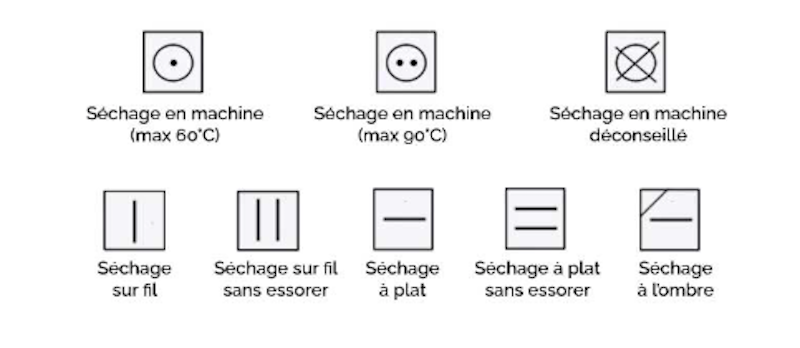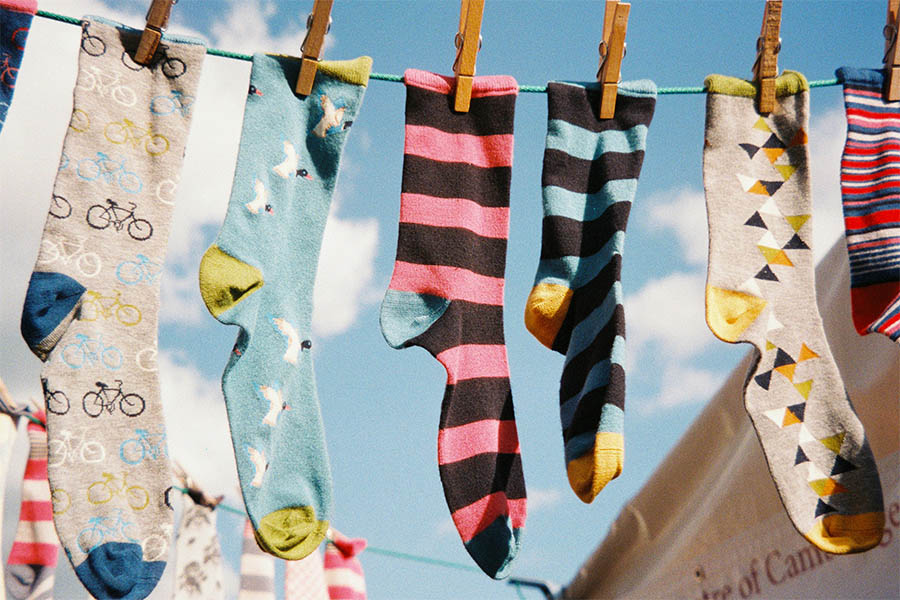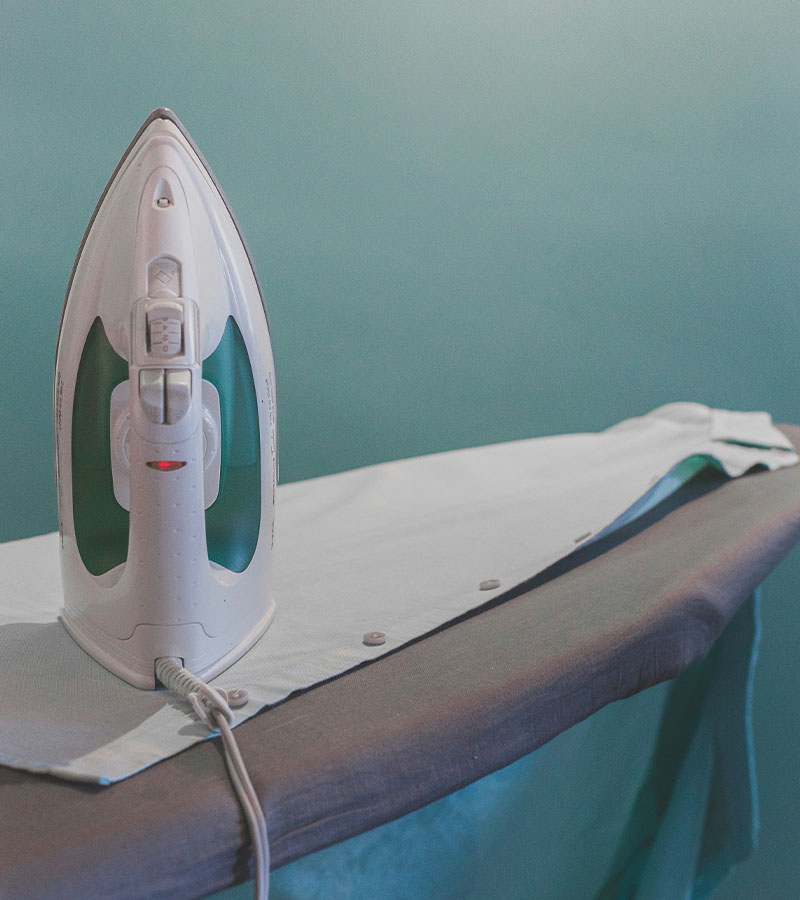Garment care guide
Garment care guide
This care guide will enable you to take care of your pretty pieces and keep your clothes longer thanks to advice on washing, drying, ironing etc.. modes. You'll also find a section on the possible second life of your clothes.
First and foremost, it's important to be familiar with the materials from which your garment is made, as care is different depending on the type of material used.
To find out the specifics, we invite you to read the article on the material in question in the glossary.
Here we'll give you some general advice on caring for your clothes.

Washing clothes:
Reading the label:
Reading the label should be a reflex as soon as you buy your clothes. It indicates the manufacturers' recommendations and the raw materials used, following these recommendations will help you preserve the garment's durability.
Symbols to be aware of:
Three types of symbol are represented for washing your clothes:
The first symbol means that you should wash your clothes at a maximum temperature of 30 degrees.
The second symbol indicates that you should avoid washing in a washing machine or by hand, in which case airing your garment may be considered sufficient. The third symbol indicates that you should avoid washing in a washing machine or by hand, in which case airing your garment may be considered sufficient.
In the third case, hand washing is recommended, or else opt for the dry-cleaning option.

Washing in a washing machine:
Machine washing clothes requires a few precautions to keep them in good condition:
Before washing, we recommend using a stain remover in small quantities if necessary.
It's important to avoid mixing certain fibers, such as cotton and wool.
Similarly, avoid mixing dark and light-colored garments to prevent fading.
Sort your garments by material, color and wash temperature. It's best not to overload.
It's best not to overload the machine so that the clothes can be washed properly.
Using the right detergent for the material and/or color of the clothes is also essential.
Don't leave clothes in the drum after washing to avoid damp odors and wrinkles.
Most garments don't need to be washed at more than 30 or 40 degrees. Washing them in low-temperature water preserves the colors of your favorite garments longer, and prevents them from warping. This technique has another significant advantage: it also saves energy.
It's also preferable to wash your clothes inside out for the sake of fiber conservation.
Dry-cleaning:
Dry cleaning is carried out at the dry cleaners: clothes are cleaned with a liquid solvent more powerful than lye to remove grease, disinfect and clean. However, care must be taken not to overuse this process, as over-cleaning can accelerate deterioration. Unless you have an accident or a stain on your clothes, simply let them air-dry to eliminate odors. Dry-cleaning is recommended for coats, suit jackets and pants.
Dry-cleaning is not at all environmentally friendly, due to the large quantity of chemicals it requires. So opt for dry-cleaning at an eco-friendly dry cleaner who won't use toxic solvents, either for you or for the planet. The result will be identical.
Coping with stubborn stains:
Stubborn stains can be divided into three categories: grease stains, plant stains and animal stains. If we wished to preserve a stained garment, it's advisable to take it to the dry cleaners. However, it is possible to do it yourself by following a few tips:
For greasy stains, remove the excess with a knife, apply a stain remover specifically for grease, then wash the garment in the washing machine.
For plant-based stains, dilute the stain with clear water at low temperature, use a suitable stain remover or white vinegar, then machine wash.
For stains of animal origin, dilute the stain with cold water, dab with a mixture of clear water and ammonia, then rinse with water at low temperature.
Certain practices should be avoided: removing a stain and leaving the garment to dry may leave rings. Avoid using a colored towel (risk of discoloration), or using salt to treat a wine stain.
Clothes bleaching:
Symbols to know:
The first symbol indicates that chlorine bleaching is permitted.
The second symbol represents single-oxygen bleaching.
The third symbol indicates that bleaching is not recommended.

Tricks to guarantee whitening:
To preserve the whiteness of your clothes, it's essential to wash them separately from colored garments. If you want to restore the immaculate shine of a white t-shirt or shirt, here are a few tips:
Use a detergent specially designed to revive white laundry.
Add a tablespoon of sodium percarbonate to your usual detergent.
Let your clothes air dry.
Drying clothes:
Symbols you need to know:
There are several options for drying your clothes, and the symbols on the following labels will help you understand the manufacturer's recommendations.

Recommendations for drying your laundry:
A few tips for efficient drying and easier ironing later:
Be sure to unfold your clothes properly.
Lay them out, leaving space between each one.
For garments made of delicate materials such as wool or cashmere sweaters, prefer to dry flat to avoid warping.
If you're drying colored garments in the sun, turn them inside out and remove them as soon as they're dry.

Ironing clothes:
Symbols to know:
A graduation is present: one dot recommends ironing at 110°C (acrylic and nylon), 2 dots for ironing at 150°C (polyester and wool), and 3 dots for ironing at 200°C (cotton and linen).

Recommendations for ironing clothes without damaging them:
There are two options for ironing: using an iron, which is the most common and economical method, or opting for a steam power plant, which offers superior efficiency. A steam iron saves time, especially when you have a lot of clothes to iron. It's also important to have an ironing board, preferably height-adjustable to suit your height. For those who prefer an alternative, a steamer can be used; it doesn't require an ironing board, doesn't take up too much space and is easily transportable.

How to give it a second life
There are different scenarios:
The garment is in good condition but no longer of interest to you:
In this case, you can donate them to your family or directly to charities.
You can also drop them off at garage sales, or sell them on second-hand platforms.
You can also entrust them to a ressourcerie, which will entrust them to its reintegration workshop for revalorization and resale.
The garment is defective but it's your favorite, you can't part with it:
All you have to do is repair it, a multitude of alternatives exist for this purpose.
If you have sewing skills, you can repair it yourself.
If you don't have the soul of a seamstress, there are several options open to you.
First of all, you can call in an outside service provider. Find all the repairers in our "Repair" article.
If you want to learn, you can always go to a sewing and repurposing workshop. There's La Textilerie in Paris, for example, where you can learn how to repair your garment.
There's also the alternative of Repair Cafes, places where volunteers eager to share their knowledge will be delighted to help you repair your clothes.
The garment is unfortunately beyond repair:
If the garment as it stands is beyond repair, it is possible to give it a second life. For example, you can upcycle it, i.e. use its fabric to make another object ( tea towel, scrunchie, pencil case) or another garment. To do this, you can entrust it to designers who will know how to give your garment a new lease of life.
If you can't give your garment a second life, simply drop it off at one of our collection points. It's important that your clothes are clean and dry, and placed in closed bags.
They will then be recycled and recycled into new clothes or innovative materials, to make insulating panels or even bricks for decorative objects.
Please don't throw your clothes in the garbage can, as they require specific treatment that cannot be carried out at all sorting centers.
Other tips:
In addition to washing/drying/ironing tips, it's important to reduce the frequency with which clothes are washed (jeans or sweaters, for example, can be worn several times before a wash). This will help you keep your favorite clothes longer, as they won't warp as much.